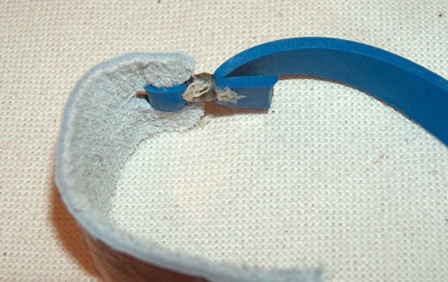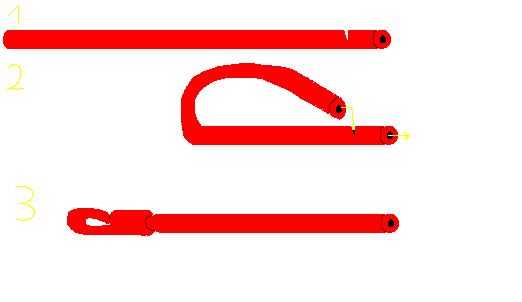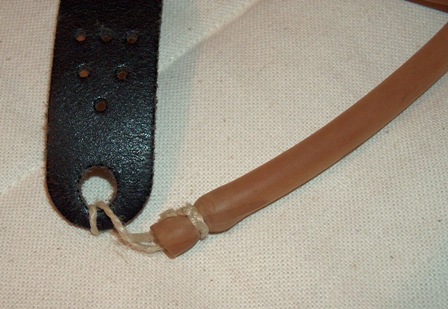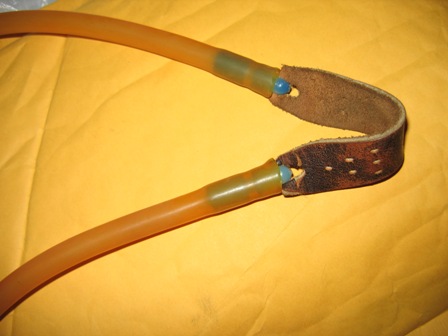There's four main things that define the performance of a slingshot: Bands, pouch, attachment of the bands to the frame and to the pouch. The latter is described in this section.
The attachment between pouch and bands is fully accelerated just like the projectile you want to propel. So every bit of weight you save has a considerable effect on your slngshot's performance. The attachment point is also an area where the bands experience a high amount of stress during the shot (tapered bands break almost always at this point), so you want to use a tying method that is easy on the bands.


This is the easiest, yet very secure and lightweight method, perfect for square or flat rubber. It works as well with tubular bands. Simply push about 1/2" through the hole of the pouch, kink, pull it taut, and wind strong string around, then snip off the excess string and rubber endpiece. The little flaps must face outside, otherwise they interact during the shot and accuracy suffers. I recommend waxed string, soft cotton or thin latex bands for best results. Please make sure that the knots are really tight! This method is used by roughly 90% of all homemade slingshots, and is widely regarded as the best way to connect the pouch to the rubber. Use this method, read on in the tying section and you won't be disappointed. I recommend Geko's constrictor knot method for a convienient and good-looking assembly.

Old Rabbit Hunter "Texas Charlie" made this method popular: First, knot a loop out of a piece of string. Next, tie this loop with a cow hitch to the pouch. Form a second cow hitch, slide it around the end of the band and pull taut. The knot will dig itself deep into the rubber and won't come loose by itself. The cool thing about this method is the ability to re-tie the pouch as soon as the bands start to break. Tapered bands tend to break just before the pouch attachment, so you don't lose more than a few milimeters of rubber when re-tying. Have a look at 9Gramm's instruction video if you have any questions.


This is by far the most common method for commercial slingshots. If you have tubular rubber, you can cut a clean round hole, about 1/4" from the end. Next, force the other end of the tube through the hole, out of the other side. Depending on its inner / outer diameter, this can require a lot of force. You must moisten the band with soapy water or alcohol. Things become easier if you have the end of a big pen, put the end of the tube inside, and push the pen through the hole. Or, you can use a needle to run a string through the end, push string through first and pull out the end.


Use a piece of string with a thick knot on it to attach the pouch: Force the knot into the tube end, and knot a piece if string tightly around the end, just behind the place where the knot is inside. The advantage is that the pouch can move free, but you lose some pull length.

This method is used in the Trumark heavy pull bands, and, in a slightly modified way, in the Saunders tubular bands. Take a piece of flat plastic-coated material (like flat electric cable), or better, one of the plastic clips you robbed off an old Trumark powerband, and force it inside the tubular band. Whatever you use, make sure it is strong and thick enough. The advantage of this method is that the pouch stays nicely aligned, but if the clip is too long and heavy, you will lose power. You can purchase a Trumark / Saunders bandset and re-use the clips after the bands are worn out - otherwise, you'll be better off using the "knot in tube" method mentioned above.

This method is easy, but your bands will not survive too many shots. It is sometimes found on very cheap commercial slingshots - simply push a round hole into the end of the band, and run the other end through. I cannot recommend this method.